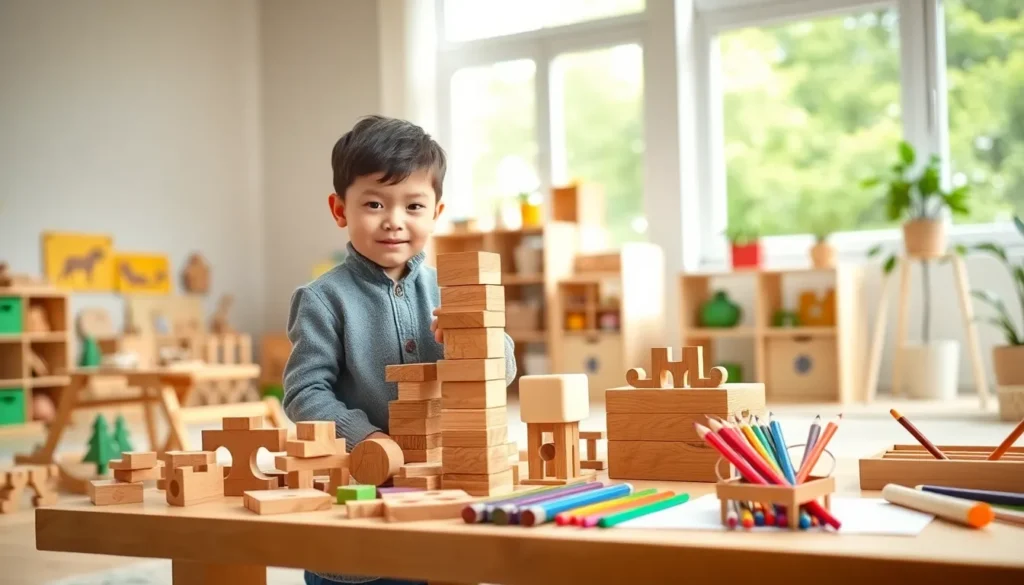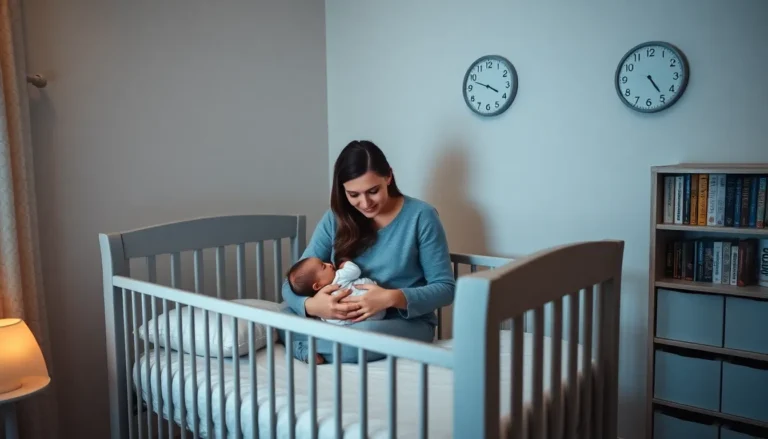Imagine a world where playtime becomes a launchpad for creativity and learning. Montessori toys for 5-year-olds do just that. With a focus on hands-on, interactive experiences, these toys not only entertain but also educate. If you think back to your childhood, chances are you can recall toys that ignited your imagination or taught you new skills. So, why should it be any different for today’s children? In this text, we jump into the intriguing realm of Montessori toys, exploring their benefits and offering suggestions that will make any parent, or grandparent, want to stock up.
Table of Contents
ToggleWhat Are Montessori Toys?

Montessori toys are carefully designed learning tools that encourage children to explore, play, and learn independently. Developed from the educational philosophy of Dr. Maria Montessori, these toys are grounded in the belief that children learn best through sensory experiences. They promote self-directed activity, allowing kids to discover new concepts at their own pace. Typically made from natural materials, such as wood, Montessori toys are aesthetically pleasing and durable. Importantly, they often lack the flashy electronics that can overwhelm a child’s imagination, allowing for creativity to flourish through open-ended play. In essence, Montessori toys are not simply for amusement: they are building blocks for skills, creativity, and understanding.
Benefits of Montessori Toys For Young Children
Montessori toys come packed with benefits that extend far beyond simple fun. Here are some key advantages:
- Promotes Independence: When children interact with Montessori toys, they take charge of their own learning experiences. They learn to solve problems and make decisions, nurturing a sense of independence that can last a lifetime.
- Encourages Critical Thinking: Montessori toys often present challenges that require kids to think critically and explore various solutions. Rather than providing them with an answer, these toys inspire curiosity and exploration, fostering a problem-solving mindset.
- Enhances Fine Motor Skills: Many Montessori toys require manipulation, whether it’s stacking blocks or threading beads. This kind of play sharpens fine motor skills, preparing children for tasks like writing and drawing.
- Supports Emotional Development: These toys can teach patience and perseverance. As children learn to navigate challenges or share with others, they build social skills and emotional intelligence.
- Fosters Collaboration: Montessori toys can help group play, allowing children to work together and learn from one another. This collaboration can nurture friendships and the ability to cooperate in a team setting.
- Stimulates Imagination: The open-ended nature of Montessori toys encourages children to use their imaginations in ways that more structured toys do not. They can pretend, create, and innovate, further nurturing their imaginative capacities.
Top Montessori Toys For 5 Year Olds
Selecting the right Montessori toys enhances educational benefits while ensuring fun. Here are some top recommendations that will cater to a 5-year-old’s developmental needs:
- Wooden Building Blocks: These come in various shapes and sizes, encouraging creativity and structure while enhancing spatial awareness.
- Puzzle Games: Three-dimensional puzzles or jigsaw puzzles help with problem-solving and hand-eye coordination, all while providing hours of entertainment.
- Montessori Numbers and Counting Toys: These toys often include colorful beads and counters that introduce children to basic math concepts in a fun, engaging manner.
- Art Supplies: Items like high-quality colored pencils or watercolor sets foster artistic expression and improve fine motor skills.
- Sorting Toys: These toys promote cognitive development through classification and sorting tasks, challenging children to think and problem-solve.
- Nature Exploration Kits: From bug catchers to plant growth kits, these toys allow children to jump into science, discovering biology through hands-on experiences.
- Balance and Coordination Toys: Toys like balance boards or bike training wheels not only support physical development but also build confidence as they master new skills.
How to Choose the Right Montessori Toy
With so many amazing options available, selecting the perfect Montessori toy can feel overwhelming. Here are some guidelines to help narrow down the choices:
- Age Appropriateness: Always check age recommendations. Toys should be suitable for your child’s developmental stage to ensure safety and effectiveness.
- Focus on Skills Development: Consider what skills the toy promotes. Whether it’s fine motor skills, emotional development, or cognitive problem-solving, choose toys that align with your child’s learning goals.
- Material Quality: Opt for natural materials like wood or non-toxic paint. The quality of materials impacts both durability and safety, crucial factors in a child’s play environment.
- Open-Ended vs. Specific Play: Choose toys that can be used in multiple ways to encourage creativity. Open-ended toys allow children to dictate play scenarios, whereas specific toys may limit imaginative options.
- Reviews and Recommendations: Look for reviews from other parents or consult educational experts. They can provide invaluable insights about what works best in real-life settings.
DIY Montessori Toy Ideas
Creating your own Montessori toys can be a fun and cost-effective way to engage your child. Here are a few simple ideas:
- Sensory Bins: Fill a bin with rice, beans, or sand and add scoops, cups, and toys. Sensory bins allow children to explore different textures while practicing fine motor skills.
- Nature Collage Materials: Collect leaves, flowers, and other natural items. Have your child create collages using glue or tape, promoting creativity while fostering a connection to nature.
- Color Sorting Games: Use colored paper cups or trays to create a sorting game with small objects around the house. This toy supports cognitive development in a hands-on way.
- Homemade Puzzles: Create a DIY puzzle by cutting a cardboard picture into pieces. Your child can assemble it, enhancing problem-solving abilities and coordination.
- Busy Boards: Make a busy board filled with zippers, buttons, switches, and other everyday items. This can keep children engaged while developing their cognitive and fine motor skills.






